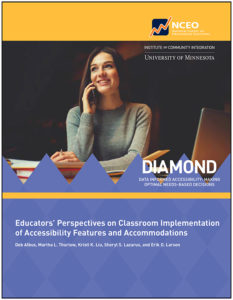 The DIAMOND project has released a report titled Educators’ Perspectives on Classroom Implementation of Accessibility Features and Accommodations. The report describes a series of telephone interviews conducted with educators in seven of the DIAMOND’s nine project states (Alabama, Connecticut, Maryland, Michigan, Minnesota, Ohio, West Virginia, Wisconsin, and the U.S. Virgin Islands). The interview data highlight educators’ understanding and implementation of accessibility features and accommodations on state assessments and in instruction.
The DIAMOND project has released a report titled Educators’ Perspectives on Classroom Implementation of Accessibility Features and Accommodations. The report describes a series of telephone interviews conducted with educators in seven of the DIAMOND’s nine project states (Alabama, Connecticut, Maryland, Michigan, Minnesota, Ohio, West Virginia, Wisconsin, and the U.S. Virgin Islands). The interview data highlight educators’ understanding and implementation of accessibility features and accommodations on state assessments and in instruction.
Participating educators reported that, in class and on assessments, they most often offered students text to speech/read aloud, extended time, use of a highlighter, use of a calculator, and a scribe. However, results also indicate an apparent confusion about the similarities and differences between the three tiers of accessibility features and accommodations (i.e., universal features, designated features, and accommodations) that are used in many state assessments. Related to that uncertainty, some teachers indicated that there were inconsistencies between the types of accessibility features and accommodations offered in the classroom and on state assessments.
The report concludes with recommendations for teacher professional development to strengthen educators’ ability to choose and implement appropriate accessibility features and accommodations.
